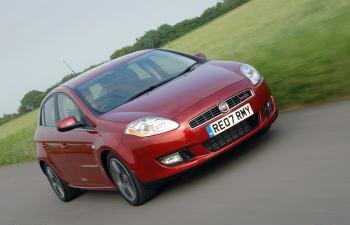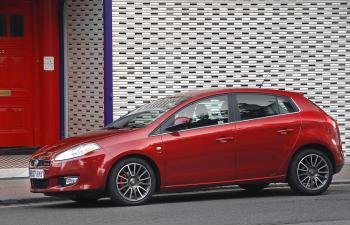|
This week across Italy
the Fiat Bravo version equipped with the exciting and
innovative brand new 150 bhp 1.4 T-Jet engine went on sale,
its arrival in Fiat's domestic market following closely on
from the UK which recently began taking orders for the T-Jet
unit to coincide with the C-segment car's launch. Available
in Italy in the higher equipped versions of the Dynamic,
Emotion and Sport packages, the new engine version has a
price list of 20,280 euros and standard equipment includes
the sophisticated ESP system and Hill Holder.
Through cubic
capacity downsizing allied to the adoption of the smallest
possible turbocharger, Fiat’s responsive new 150 bhp 1.4
litre T-Jet engine combines performance equal to or better
than a conventionally aspirated 1.8/2.0 litre petrol engine,
but with a reduction of between 10 percent and 20 percent in
fuel consumption and emissions. These advantages are
especially useful, given the importance of the fleet market,
where taxation plays a major role. A 120 bhp version of this
new unit, with performance equal to or better than a
conventionally aspirated 1.6 litre petrol engine, will be
added to the range in due course.
The arrival of the new 150 bhp T-Jet engine
has increased the range of a model that is already
experiencing a great public success, verified by over 55,000
orders since its launch (end of January 2007) up to 30th of
June, with over 50 percent of these coming outside Italy. In
Italy from April up to date the Fiat Bravo is the leader of
its segment with an average share of almost 17 percent of
the market. The mix of sales composition is biggest in the
highest versions available: 35 percent of customers have
chosen the top of the range versions (Emotion and Sport)
while 60 percent have gone for the Dynamic version; the
preferred engine, by 70 percent of customers is the 1.9
Multijet with 120 bhp.
T-Jet
The new 1.4 T-Jet is the first one of a new
family of engines.
The 120 bhp and
150 bhp 1.4 litre 16 valve T-Jet engines are the first
examples of a new family of turbocharged petrol units
developed by Fiat Powertrain Technologies to combine the
sporting performance and low NVH characteristics of a petrol
engine with fuel economy comparable to a diesel unit and CO2
emission levels which readily comply with increasingly
stringent European regulation. Through cubic capacity
downsizing allied to the adoption of the smallest possible
turbocharger, Fiat’s responsive new 120 bhp and 150 bhp 1.4
litre T-Jet engines combine a performance equal to or better
than a conventionally aspirated 1.6/1.8/2.0 litre engine.
|
 |
|
In
Italy from April up to date the Fiat Bravo is the
leader of its segment with an average share of
almost 17 percent of the market. |
|
|
 |
|
This week in Italy
the Fiat Bravo equipped with new 150 bhp 1.4 T-Jet
engine went on sale, its arrival following closely
on from the UK market which recently began taking
orders for the T-Jet. |
|
|
This is achieved along with a reduction of between 10
percent and 20 percent in fuel consumption and emissions.
Employing state-of-the-art computer aided design and
calculation systems to simulate unit stress under
turbocharging, every aspect of the 1.4 litre powerplant has
been re-evaluated. Three-dimensional computational
fluid-dynamics studies of the entire thermodynamic cycle,
injection phase and the engine cooling circuit, as well as
thermo-mechanical analysis of cylinder head, block and
piston stress resulted in comprehensive redevelopment of the
combustion system, intake and exhaust manifolds, cam
profiles and phasing, intake system, engine coolant
circulation and spark plugs.
The new T-Jet
engines feature optimised intake port and manifold design; a
revised injection system and bespoke spark plug design to
improve knock resistance and pre-ignition; a reduction in
both inlet and exhaust valve lift time to optimise air mass
flow; a reduction in compression ratio from 11:1 to 9.8:1;
piston, con-rod and crankshaft redesign; a new, reduced
volume exhaust manifold for maximum exploitation of the
exhaust pulse energy, and improved engine cooling efficiency
through a revised coolant path and a redesigned water pump
impeller.
Excellent combustion characteristics have allowed
for the adoption of a notably small turbocharger. With a
turbine diameter of only 33 mm, this highly compact and
responsive turbine is located directly above the exhaust
manifold, with the attendant catalytic converter
close-coupled to the turbine exit.
Via a
‘drive-by-wire’ throttle system, the new 1.4 litre T-Jet
engines provide outstanding low-end torque, almost entirely
devoid of the lag in power delivery traditionally associated
with turbocharger installations. The 150 bhp T-Jet engine
offers identical torque delivery at 1750 rpm but, via an
‘overboost’ button located on the centre console in Sport
versions, will deliver an impressive 170 lb ft at 3000 rpm,
endowing the Bravo with a 0-62 mph acceleration time of 8.2
seconds and a top speed of 131 mph. Notwithstanding such
lively performance, this superbly responsive powerplant will
still return nearly 40 mpg in the combined cycle and
restrict CO2 emissions to just 167 g/km.
|
|
|
|